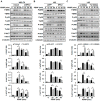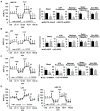Niemann-Pick Type C2 Protein Regulates Free Cholesterol Accumulation and Influences Hepatic Stellate Cell Proliferation and Mitochondrial Respiration Function
- PMID: 29874879
- PMCID: PMC6032364
- DOI: 10.3390/ijms19061678
Niemann-Pick Type C2 Protein Regulates Free Cholesterol Accumulation and Influences Hepatic Stellate Cell Proliferation and Mitochondrial Respiration Function
Abstract
Liver fibrosis is the first step toward the progression to cirrhosis, portal hypertension, and hepatocellular carcinoma. A high-cholesterol diet is associated with liver fibrosis via the accumulation of free cholesterol in hepatic stellate cells (HSCs). Niemann-Pick type C2 (NPC2) plays an important role in the regulation of intracellular free cholesterol homeostasis via direct binding with free cholesterol. Previously, we reported that NPC2 was downregulated in liver cirrhosis tissues. Loss of NPC2 enhanced the accumulation of free cholesterol in HSCs and made them more susceptible to transforming growth factor (TGF)-β1. In this study, we showed that knockdown of NPC2 resulted in marked increases in platelet-derived growth factor BB (PDGF-BB)-induced HSC proliferation through enhanced extracellular signal-regulated kinases (ERK), p38, c-Jun N-terminal kinases (JNK), and protein kinase B (AKT) phosphorylation. In contrast, NPC2 overexpression decreased PDGF-BB-induced cell proliferation by inhibiting p38, JNK, and AKT phosphorylation. Although NPC2 expression did not affect caspase-related apoptosis, the autophagy marker light chain 3β (LC3B) was decreased in NPC2 knockdown, and free cholesterol accumulated in the HSCs. The mitochondrial respiration functions (such as oxygen consumption rate, ATP production, and maximal respiratory capacity) were decreased in NPC2 knockdown, and free cholesterol accumulated in the HSCs, while NPC2-overexpressed cells remained normal. In addition, NPC2 expression did not affect the susceptibility of HSCs to lipopolysaccharides (LPS), and U18666A treatment induced free cholesterol accumulation, which enhanced LPS-induced Toll-like receptor 4 (TLR4), nuclear factor kappa-light-chain-enhancer of activated B cells (NF-κB) p65 phosphorylation, interleukin (IL)-1 and IL-6 expression. Our study demonstrated that NPC2-mediated free cholesterol homeostasis controls HSC proliferation and mitochondrial function.
Keywords: Niemann-Pick type C2; free cholesterol; hepatic stellate cells; mitochondrial function; platelet-derived growth factor BB.
Conflict of interest statement
The authors declare no conflict of interest.
Figures







Similar articles
-
Niemann-Pick Type C2 Protein Mediates Hepatic Stellate Cells Activation by Regulating Free Cholesterol Accumulation.Int J Mol Sci. 2016 Jul 13;17(7):1122. doi: 10.3390/ijms17071122. Int J Mol Sci. 2016. PMID: 27420058 Free PMC article.
-
Niemann-Pick type C2 protein regulates liver cancer progression via modulating ERK1/2 pathway: Clinicopathological correlations and therapeutical implications.Int J Cancer. 2015 Sep 15;137(6):1341-51. doi: 10.1002/ijc.29507. Epub 2015 Mar 24. Int J Cancer. 2015. PMID: 25754535
-
Niemann-Pick type C2 deficiency impairs autophagy-lysosomal activity, mitochondrial function, and TLR signaling in adipocytes.J Lipid Res. 2016 Sep;57(9):1644-58. doi: 10.1194/jlr.M066522. Epub 2016 Jul 8. J Lipid Res. 2016. PMID: 27402802 Free PMC article.
-
Niemann-Pick C2 (NPC2) and intracellular cholesterol trafficking.Biochim Biophys Acta. 2009 Jul;1791(7):671-8. doi: 10.1016/j.bbalip.2009.02.001. Epub 2009 Feb 13. Biochim Biophys Acta. 2009. PMID: 19232397 Free PMC article. Review.
-
Roles of the lipid metabolism in hepatic stellate cells activation △.Chin Med Sci J. 2013 Dec;28(4):233-6. doi: 10.1016/s1001-9294(14)60008-0. Chin Med Sci J. 2013. PMID: 24382226 Review.
Cited by
-
Is autophagy an elective strategy to protect neurons from dysregulated cholesterol metabolism?Neural Regen Res. 2019 Apr;14(4):582-587. doi: 10.4103/1673-5374.247441. Neural Regen Res. 2019. PMID: 30632494 Free PMC article. Review.
-
Resveratrol Inhibits Hepatic Stellate Cell Activation via the Hippo Pathway.Mediators Inflamm. 2021 Oct 13;2021:3399357. doi: 10.1155/2021/3399357. eCollection 2021. Mediators Inflamm. 2021. PMID: 34690551 Free PMC article.
-
Niemann-Pick Disease Type C (NPDC) by Mutation of NPC1 and NPC2: Aberrant Lysosomal Cholesterol Trafficking and Oxidative Stress.Antioxidants (Basel). 2023 Nov 21;12(12):2021. doi: 10.3390/antiox12122021. Antioxidants (Basel). 2023. PMID: 38136141 Free PMC article. Review.
-
Secretory NPC2 Protein-Mediated Free Cholesterol Levels Were Correlated with the Sorafenib Response in Hepatocellular Carcinoma.Int J Mol Sci. 2021 Aug 9;22(16):8567. doi: 10.3390/ijms22168567. Int J Mol Sci. 2021. PMID: 34445279 Free PMC article.
-
Metabolic Sparks in the Liver: Metabolic and Epigenetic Reprogramming in Hepatic Stellate Cells Activation and Its Implications for Human Metabolic Diseases.Diabetes Metab J. 2025 May;49(3):368-385. doi: 10.4093/dmj.2025.0195. Epub 2025 May 1. Diabetes Metab J. 2025. PMID: 40367987 Free PMC article. Review.
References
-
- Moreira R.K. Hepatic stellate cells and liver fibrosis. Arch. Pathol. Lab. Med. 2007;131:1728–1734. - PubMed
MeSH terms
Substances
LinkOut - more resources
Full Text Sources
Other Literature Sources
Medical
Research Materials
Miscellaneous

